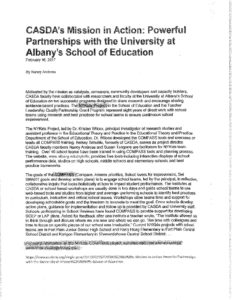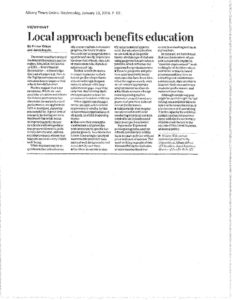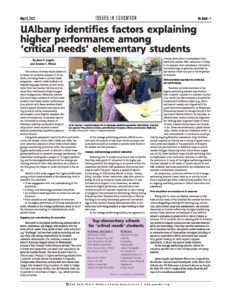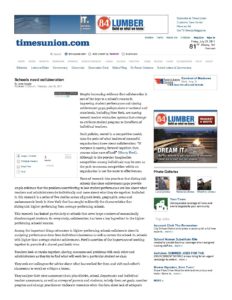Format: News Media Article
The goals of the COMPASS (Compare, Assess priorities, Select levers for improvement, Set SMART goals and develop action plans) is to engage school teams, led by the principal. In reflective, collaborative inquiry that looks holistically at how to impact student performance.
Motivated by the mission as catalysts, conveners, community developers and capacity builders, CASDA faculty have collaborated with researchers and faculty at the University at Albany’s School of Education on two successful programs designed to share research and encourage sharing evidence-based practices. The NYKids Project in the School of Education and the Teacher Leadership Quality Partnership Grant Program represent eight years of direct work with school teams using research and best practices for school teams to ensure continuous school improvement.
The goals of the COMPASS (Compare, Assess priorities, Select levers for improvement, Set SMART goals and develop action plans) is to engage school teams, led by the principal. In reflective, collaborative inquiry that looks holistically at how to impact student performance.
This article discusses the recent reauthorization of the federal Elementary and Secondary Education Action, known as Every Student Succeeds Act (ESSA).
The recent reauthorization of the federal Elementary and Secondary Education Action, known as ESSA – Every Student Succeeds Act – acknowledges that past attempts (e.g. Race to the Top) by government to tell educators how to improve their schools have fallen short. Studies suggest that’s not surprising. While we commend the attention and efforts the federal government has shown for the nation’s school performance, we applaud the shift to localized, statewide accountability. A great deal of research, including our own, has found that what works in improving performance in schools is allowing educators to use evidence to guide locally determined, continuous improvement efforts that take into account every child’s well-being.
This article describes the work of the NYKids project to identify factors explaining higher performance among critical needs elementary students. Critical needs students include those with special needs and English Language Learners, as well as those living in poverty and students from traditionally disadvantaged racial backgrounds.
This article describes the work of the NYKids project to identify factors explaining higher performance among critical needs elementary students. Critical needs students include those with special needs and English Language Learners, as well as those living in poverty and students from traditionally disadvantaged racial backgrounds. Results of study suggest factors include: (1) close engagement with and understanding of students; (2) literacy- and technology-enriched instruction; (3) an evidence-based approach to curriculum and performance; and (4) fluid adaption and deployment of resources.
Evidence indicates that collaboration is one of the keys to a school’s success in improving student performance and closing achievement gaps, though policymakers at the national and state levels, including New York, are moving toward teacher evaluation systems that attempt to attribute student progress to the efforts of individual teachers.
Evidence indicates that collaboration is one of the keys to a school’s success in improving student performance and closing achievement gaps, though policymakers at the national and state levels, including New York, are moving toward teacher evaluation systems that attempt to attribute student progress to the efforts of individual teachers.




